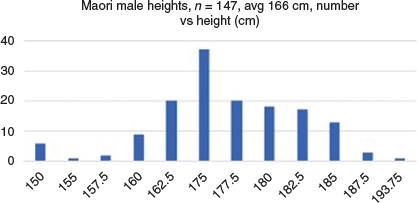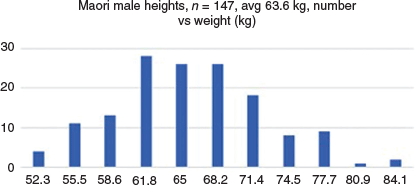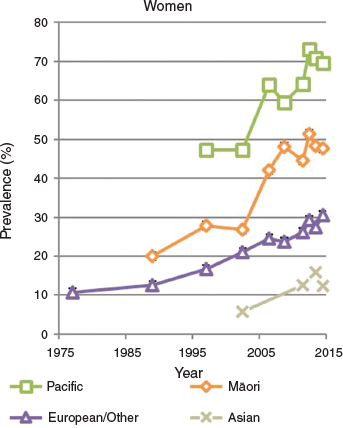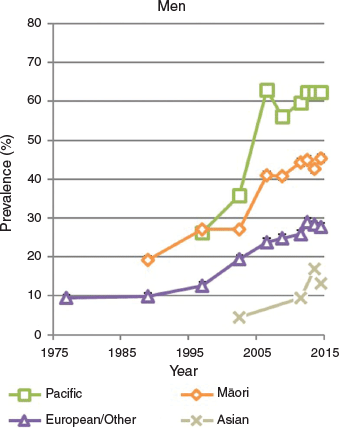Were warriors once low carb? Commentary on New Zealand Māori nutrition and anthropometrics over the last 150 years
Marcus Hawkins 1Botany Doctor Medical Practice, Botany Town Centre, 588 Chapel Road, Botany, Auckland, New Zealand. Email: marcus@botanydoctor.co.nz
Journal of Primary Health Care 13(2) 106-111 https://doi.org/10.1071/HC20129
Published: 31 March 2021
Journal Compilation © Royal New Zealand College of General Practitioners 2021 This is an open access article licensed under a Creative Commons Attribution-NonCommercial-NoDerivatives 4.0 International License
Abstract
Obesity is a scourge on modern society and an epidemic has exploded in the developed world over the last half century, resulting in sicker populations and economically unsustainable health expenditure. The Pacific region became colonised by Europeans from the early nineteenth century onwards and, as a consequence, ‘European’ foodstuffs were introduced to New Zealand Māori. This has intensified over the last 150 years; so much so, that obesity is now common among New Zealand Māori, who suffer disproportionately from the chronic diseases arising from obesity.
This commentary seeks to explore and compare the ‘then’ and ‘now’ in terms of New Zealand Māori nutrition and anthropometrics. It also asks the specific questions: were New Zealand Māori originally eating a low carbohydrate healthy fat diet? and should we all now reflect on a previous dietary pattern of eating in an effort to reverse the obesity epidemic?
KEYwords: Obesity; Diabetes; Diet and carbohydrates; Health economics; Health management; Indigenous health; Non-communicable diseases; Pacific communities; Population health
OBESITY THROUGH HISTORY
Is there evidence of obesity in earlier times? One can perhaps get closer to the true answer to this question by considering pre-historic cave paintings. These images suggest that populations were not obese as there are few overweight characters depicted. When other early art forms are reviewed, nude figurines with obesity-related features are found, dating back to 20,000 years ago (Figure 1). They are regarded as representations of female deities and female fecundity rather than perhaps reflecting the general population.1–3

|
Prehistoric populations were hunter–gatherers, living at subsistence level, hunting animals and eating vegetation. Approximately 10,000 years ago, many cultures became organised as agriculturalists, and animal husbandry is portrayed in Egyptian hieroglyphs.4 In agrarian societies, such as the Egyptians and medieval Europeans, humans were generally portrayed as lean. Images start to feature corpulence in the artwork of Paul Rubens (1577–1640), Rembrandt (1606–1669) and Georgian and Victorian paintings, especially in the upper echelons of society or with the artistic licence of classical art, more often than not signifying wealth or beauty.3,5
It is only in the last 200 years that we have true photographic documentation of human physique and this aids significantly in researching the question raised in this narrative. Science has documented and studied human anthropometrics since the 1830s,6 or about the same time span as photography has been around, but there is little indication of obesity as a prevalent issue, arguably as also evidenced by the lack of published scientific material on the subject.
Obesity has become a ‘new’ feature in the financially advantaged world and coincides with the nutritional advice that spread to first world nations. Worldwide, obesity has nearly tripled since 1975.7 With respect to Māori, the World Health Organization (WHO) has stated that ‘Before European contact, the food behaviour of the people of the Pacific region may have remained the same for millennia.’ ‘Pacific people were described as strong, muscular and mostly in good health.’8
MĀORI NUTRITION BEFORE EUROPEAN COLONISATION
New Zealand Māori, the Tangata Whenua (people of the land), the indigenous people of New Zealand (Aotearoa) are estimated to have migrated from East Polynesia ca. 1280AD. They arrived with 11 plant species, dogs and rats. Their traditional diet consisted of meat, vegetables and seafood (M. Schmidt, pers. comm.) Protein came from kiore (Polynesian rat) and kurī (Polynesian dog) and they hunted a wide range of birds including the large flightless moa. The sea, lakes and waterways provided fish, seals, shellfish, Inanga (whitebait), eels, whales, dolphins and seaweed.9
Moa became extinct as did seals in some localities, and subsequently, cultigens became more established with kumara plots as far south as Banks Peninsula and taro and yams in Northland (M. Schmidt, pers. comm.). These were not a major staple of daily diet, but were revered and stored for specific occasions.9 Aotearoa was originally covered with dense native bush and provided edible vegetation such as ferns, vines, palms, fungi and berries.10,11 Food sources are corroborated from analysis of carbon and nitrogen stable isotope ratios in human bone collagen.12 Buck reports that Māori originally ate one or two meals a day.13 Feasting was a time of celebration or religious ceremony and required participants to eat more than they normally would, both fatty and carbohydrate-rich foods. Fresh water was the only beverage apart from medicinal preparations.14 There was no kava or other fermented alcoholic production.
EARLY MĀORI PHYSIQUE AND ANTHROPOMETRICS
Early European explorers noted South Pacific peoples were generally lean. In 1769–70, James Cook described Māori as ‘a Strong, rawboned, well made, Active People, rather above than under the common size, especially the Men’.14 Joseph Banks, who travelled with Cook, noted ‘men are of the size of the larger Europaeans, Stout, Clean Limnd and active, fleshy but never fat’ ‘vigorous, nimble…’.15 Banks reported Māori women ‘rather smaller than Europaean women’. Buck described ‘pre-European Māori among the tallest races of the world and the muscular development of the legs was the finest known. The standard of physique was very high, and he excelled in athletic exercises’ and ‘These factors cannot be considered apart from diet in the aetiology of the Māori physique’.13 This was also Houghton’s opinion of pre-colonial New Zealanders.16
There is a paucity of anthropometric data on nineteenth century Māori. One study from 185417 measured the heights and weights of 147 adult male Māori, concluding ‘the average weight is rather under that of the natives of Great Britain’. Figure 2 shows the height distribution of Maori males in this study and Figure 3 shows their weight distribution. The average body mass index (BMI) of these men is 22.8 kg/m2, which is lean and falls within the normal recommended range.18
There are many paintings, drawings and photographs of Māori since colonisation. Pictorial and photographic records can be cherry-picked, but it is evident from review of collections at Auckland Museum and the National Museum at Te Papa in Wellington, that Māori were not overtly overweight or obese (see Supplementary materials Figures S1–S7, available at the journal’s website).
THE RECENT STATE OF AFFAIRS
Obesity has become a significant problem in New Zealand since European colonisation when food such as potatoes and wheat were introduced.8 Obesity statistics have not been routinely collected in the interim period. However, it is true that there is currently an obesity problem in New Zealand. In 2012, New Zealand was the third most obese nation in the Organisation for Economic Co-operation and Development (OECD).19 Figure 4 shows how obesity has increased between 1977 and 2012. In 2020, New Zealand children had the second-highest obesity rate in the OECD, with one in three children being obese or overweight.20

|
New Zealand Māori constituted 16.5% of the population, with obesity rates of >45% in 2015.21 Māori and Polynesians have become more obese over the last half century. Figure 5 (women) and Figure 6 (men) show the prevalence of obesity by ethnicity in New Zealand from 1975–2015.22 In 2013–14, Māori adults aged >25 years were ~1.5-fold as likely as non-Māori adults to have been diagnosed with diabetes.23
Discussion
Humankind has not always had an issue with obesity. Prehistoric hunter-gatherers ate a high-fat, high-protein and low-carbohydrate diet. Carbohydrates would have been derived as seasonably available uncultivated fruit and vegetables. Fat and protein came from hunted animals. More modern-day hunter–gatherers were or are lean and athletic.24,25 They often ate or eat a high-fat, low-carbohydrate diet and are mostly free of obesity. Examples include the Inuit24 before introduction of the Western diet and the Masai.25 It is reasonable to assume that prehistoric humans were not often obese.
As for Māori, before European colonisation, they had established a complex and well-organised agrarian existence in conjunction with hunting and gathering. They cultivated starchy vegetables, but it is likely that their diets were not carbohydrate dense. With the introduction of the low-fat, high-carbohydrate dietary guidelines in the 1970s, there has been an massive increase in obesity and its associated comorbidities.7 Obesity has affected all New Zealanders, but rates of obesity, and in particular morbid obesity, are particularly high in Māori.
Reversal of the obesity epidemic may lie in a diet with more whole foods and reduced glycaemic load (low carbohydrate healthy fat (LCHF) eating). This might best be achieved by concomitant reduction in ultra-processed foods. There is increasing evidence that an LCHF diet is beneficial for weight loss, reversal and improvement of prediabetes, diabetes, hypertension, metabolic syndrome and non-alcoholic fatty liver disease.26–28 It has been shown that a well-structured LCHF diet is nutritionally complete.29 Recommending this in primary care can show real and sustained results. It is straightforward to implement and rewarding for both health professionals and patients.30 LCHF eating can mean less expenditure on doctors’ visits and medication.
I have supported a patient through this process. They reversed their type 2 diabetes and were able to stop glargine insulin 65 units daily and continue as prediabetic with no diabetic medications. This saved the New Zealand Taxpayer NZ$4484 in the cost of insulin alone in 1 year.31 General practitioner, Dr David Unwin, has shown it is possible to reverse type 2 diabetes, reduce medication use and significantly improve important health parameters.32,33 Virta Health has done this on a larger scale.27
It is often suggested that LCHF eating is more expensive than a regular diet, but the increase in expenditure is almost negligible.34 Expense may be mitigated by buying cheaper, fattier cuts of meat and seasonal and local vegetables. The poor in society are at the mercy of food producers. Highly processed and carbohydrate-rich foods are cheap, rapidly digested and allow hunger to return sooner than diets with more fat and protein. This has a financial advantage for food producers. The cost of foods also does not reflect their nutritional value; nutritionally poor soft drinks are much cheaper than nutritionally rich drinks such as milk. The clustering of cheap fast-food outlets in poorer suburbs also reflects the demographic distribution of obesity.
Consideration needs to be given to regulation of sales through Government-led deterrents against very high carbohydrate-containing foods, often highly processed and with very little nutritional value. This might include a sugar tax and legislation against product placement at the eye-level of children, particularly in the most vulnerable populations and especially in the most impoverished areas. We also need nutrition education to begin at school and continue throughout life. This will all fail, however, if poverty forces only cheap, nutritionally poor food to be consumed and there is no political will to affect change.
The health benefits of a reduced carbohydrate and more wholefoods way of eating would be expected to benefit most those who are most affected by obesity and its consequences. This is particularly pertinent to Māori who are also economically disadvantaged.35
This article is about Māori and how modern foods have made them less healthy than in pre-European times, but is also intended to indicate a way forward to better health for Māori, through a change in nutrition advice and returning to a more traditional diet. Māori involvement in this process is critical as they have a wealth of traditional knowledge to help it succeed. Cost-saving strategies alluded to above, as well as ideas such as communal gardens, would not be a new concept to Māori and would represent a connection with traditional culture.
SUMMARY
Obesity has affected the Pacific in what was once the domain of warrior peoples with physiques held in high esteem. We cannot afford for this to continue; too many sick people, too many deaths and health systems collapsing under the financial burden. The solution is not simple, but must involve the Government addressing poverty and nutritional and health literacy. There has to be political will if we are to save a financially overstretched public health service. The alternative is unsustainable.
Obesity is particularly relevant in this age of COVID-19. Risk of serious complications or death are significantly increased with obesity and when diabetes and renal failure are present.36 It would be an opportune time indeed to have more media and Government emphasis on the adverse health outcomes associated with obesity.
So, were warriors once low carb? I believe the answer to the question asked in the title is highly likely to be ‘yes’. We can often learn from the past and we should learn from the consequences of past nutrition advice. There is a disproportionately high incidence of preventable disease in New Zealand Māori. We can reflect on where Tangata Whenua came from in terms of nutrition and health, and return to a different and less processed way of eating. We should support Māori, with their traditional knowledge, so that they can help to regain their collective health, in part by dietary change and return to a concept that was once for warriors.
Competing interests
The author has no competing interests to declare.
Funding
The author did not receive any funding for this study.
References
[1] Colman E. Obesity in the paleolithic era? The Venus of Willendorf. Endocr Pract. 1998; 4 58–9.| Obesity in the paleolithic era? The Venus of Willendorf.Crossref | GoogleScholarGoogle Scholar |
[2] Haslam D, Rigby N. The art of medicine: a long look at obesity. Lancet. 2010; 376 85–6.
| The art of medicine: a long look at obesity.Crossref | GoogleScholarGoogle Scholar | 20629209PubMed |
[3] Woodhouse R. Frontiers of Hormone Research. vol. 36. Basel: KARGER; 2008. pp. 271–286.
[4] Eknoyan G. A history of obesity, or how what was good became ugly and then bad. Adv Chronic Kidney Dis. 2006; 13 421–7.
| A history of obesity, or how what was good became ugly and then bad.Crossref | GoogleScholarGoogle Scholar | 17045228PubMed |
[5] Clark K. Civilisation. London: BBC & John Murray Books; 1969.
[6] Villermé L. Mémoire sur la taille de l’homme en France. Ann d’Hygiène Publique Médicine Légale. 1829; 1 551–9.
[7] World Health Organization. Obesity and overweight. Geneva: WHO; 2020. [cited 2021 March 9]. Available from: https://www.who.int/en/news-room/fact-sheets/detail/obesity-and-overweight
[8] World Health Organization. Diet, food supply and obesity in the Pacific. Geneva: WHO; 2003. [cited 2021 March 9]. Available from: https://apps.who.int/iris/bitstream/handle/10665/206945/9290610441_eng
[9] T.E. of N.Z. Te Ara. Story: Māori foods – kai Māori. 2013. [cited 2021 March 19]. Available from: https://teara.govt.nz/en/maori-foods-kai-maori.
[10] Macnab JW. Sweet potatoes and Māori terraces in the Wellington area. J Polyn Soc. 1969; 78 83–111.
[11] Hargreaves RP. Changing Maori agriculture in pre-Waitangi New Zealand. J Polyn Soc. 1963; 72 101–17.
[12] Kinaston RL, Walter RK, Jacomb C, et al. The first New Zealanders: patterns of diet and mobility revealed through isotope analysis. PLoS One. 2013; 8 e64580
| The first New Zealanders: patterns of diet and mobility revealed through isotope analysis.Crossref | GoogleScholarGoogle Scholar | 23691250PubMed |
[13] Buck PH. Maori diet. Med J Aust. 1927; 5 146–50.
[14] Cook J, Wharton WJL. Captain Cook’s Journal During His First Voyage Round the World: Made in H.M. Bark “Endeavour” 1768–71. London: Elliot Stock; 1893.
[15] Banks J, Beaglehole JC. The Endeavour journal of Joseph Banks, 1768–1771. Sydney: Trustees of the Public Library of New South Wales in association with Angus and Robertson; 1963.
[16] Houghton P. Prehistoric New Zealanders. N Z Med J. 1978; 87 213–6.
| 351477PubMed |
[17] Thomson AS. Contribution to the natural history of the New Zealand race of men; Being observations on their stature, weight, size of chest, and physical strength. J Stat Soc Lond. 1854; 17 27
| Contribution to the natural history of the New Zealand race of men; Being observations on their stature, weight, size of chest, and physical strength.Crossref | GoogleScholarGoogle Scholar |
[18] National Health Service. What is the body mass index (BMI)? 2019. [cited 2021 March 9]. Available from: https://www.nhs.uk/common-health-questions/lifestyle/what-is-the-body-mass-index-bmi/
[19] New Zealand Ministry of Health. New Zealand obesity rates 1977–2012. 2019. [cited 2021 March 9]. Available from: https://www.health.govt.nz/nz-health-statistics/health-statistics-and-data-sets/obesity-statistics.
[20] Gromada A, Rees G, Chzhen Y. Worlds of influence: understanding what shapes child well-being in rich countries. Innocenti Report Card no. 16. Innocenti, Florence: UNICEF Office of Research; 2020.
[21] Statistics New Zealand. New Zealand Ethnicity 2019. Wellington, New Zealand: Statistics New Zealand; 2019. [cited 2021 March 9]. Available from: https://www.stats.govt.nz/tools/2018-census-place-summaries
[22] Teng AM, Atkinson J, Disney G, et al. Ethnic inequalities in cancer incidence and mortality: census-linked cohort studies with 87 million years of person-time follow-up. BMC Cancer. 2016; 16 755
| Ethnic inequalities in cancer incidence and mortality: census-linked cohort studies with 87 million years of person-time follow-up.Crossref | GoogleScholarGoogle Scholar | 27669745PubMed |
[23] New Zealand Health Survey. Wellington, New Zealand: Ministry of Health; 2014. [cited 2021 March 9]. Available from: https://www.health.govt.nz/nz-health-statistics/national-collections-and-surveys/surveys/new-zealand-health-survey#2013-14.
[24] Stefansson V. The Friendly Arctic: the Story of Five Years In Polar Regions. New York: The Macmillan Company; 1922.
[25] Mann GV, Shaffer RS, Andersin HH, et al. Cardiovascular disease in the masai. J Atheroscler Res. 1964; 4 289–312.
| Cardiovascular disease in the masai.Crossref | GoogleScholarGoogle Scholar | 14193818PubMed |
[26] Vilar-Gomez E, Athinarayanan SJ, Adams RN, et al. Post hoc analyses of surrogate markers of non-alcoholic fatty liver disease (NAFLD) and liver fibrosis in patients with type 2 diabetes in a digitally supported continuous care intervention: an open-label, non-randomised controlled study. BMJ Open. 2019; 9 e023597
| Post hoc analyses of surrogate markers of non-alcoholic fatty liver disease (NAFLD) and liver fibrosis in patients with type 2 diabetes in a digitally supported continuous care intervention: an open-label, non-randomised controlled study.Crossref | GoogleScholarGoogle Scholar | 30803948PubMed |
[27] Athinarayanan SJ, Adams RN, Hallberg SJ, et al. Long-term effects of a novel continuous remote care intervention including nutritional ketosis for the management of type 2 diabetes: a 2-year non-randomized clinical trial. Front Endocrinol. 2019; 10 348
| Long-term effects of a novel continuous remote care intervention including nutritional ketosis for the management of type 2 diabetes: a 2-year non-randomized clinical trial.Crossref | GoogleScholarGoogle Scholar |
[28] Noakes TD, Windt J. Evidence that supports the prescription of low-carbohydrate high-fat diets: a narrative review. Br J Sports Med. 2017; 51 133–9.
| Evidence that supports the prescription of low-carbohydrate high-fat diets: a narrative review.Crossref | GoogleScholarGoogle Scholar | 28053201PubMed |
[29] Zinn C, Rush A, Johnson R. Assessing the nutrient intake of a low-carbohydrate, high-fat (LCHF) diet: a hypothetical case study design. BMJ Open. 2018; 8 e018846
| Assessing the nutrient intake of a low-carbohydrate, high-fat (LCHF) diet: a hypothetical case study design.Crossref | GoogleScholarGoogle Scholar | 29439004PubMed |
[30] Hawkins M. Pork scratchings, cheese and kaimoana: a general practitioner’s commentary on low carbohydrate, healthy fat eating. J Prim Health Care. 2019; 11 308–10.
| Pork scratchings, cheese and kaimoana: a general practitioner’s commentary on low carbohydrate, healthy fat eating.Crossref | GoogleScholarGoogle Scholar |
[31] PHARMAC. Online Pharmaceutical Schedule - March 2021. Wellington: New Zealand. [cited 2021 March 9]. Available from: https://schedule.pharmac.govt.nz/ScheduleOnline.php?osq=lantus
[32] Unwin DJ, Tobin SD, Murray SW, et al. Substantial and sustained improvements in blood pressure, weight and lipid profiles from a carbohydrate restricted diet: an observational study of insulin resistant patients in primary care. Int J Environ Res Public Health. 2019; 16 2680
| Substantial and sustained improvements in blood pressure, weight and lipid profiles from a carbohydrate restricted diet: an observational study of insulin resistant patients in primary care.Crossref | GoogleScholarGoogle Scholar |
[33] Unwin D. Low carb diet way forward to reversing type 2 diabetes – GP. [cited 2021 March 9]. Available from: https://www.drwf.org.uk/news-and-events/news/low-carb-diet-way-forward-reversing-type-2-diabetes-gp.
[34] Zinn C, North S, Donovan K, et al. Low‐carbohydrate, healthy‐fat eating: a cost comparison with national dietary guidelines. Nutr Diet. 2020; 77 283–91.
| Low‐carbohydrate, healthy‐fat eating: a cost comparison with national dietary guidelines.Crossref | GoogleScholarGoogle Scholar | 31020780PubMed |
[35] Ministry of Health. Socioeconomic indicators. 2018. [cited 2021 March 9]. Available from: https://www.health.govt.nz/our-work/populations/maori-health/tatau-kahukura-maori-health-statistics/nga-awe-o-te-hauora-socioeconomic-determinants-health/socioeconomic-indicators.
[36] Sattar N, McInnes IB, McMurray JJV. Obesity is a risk factor for severe COVID-19 infection. Circulation. 2020; 142 4–6.
| Obesity is a risk factor for severe COVID-19 infection.Crossref | GoogleScholarGoogle Scholar | 32320270PubMed |






